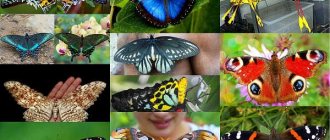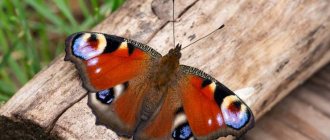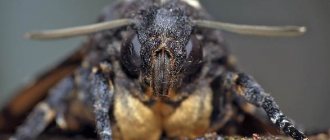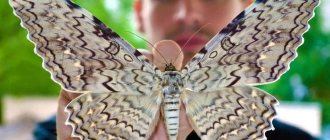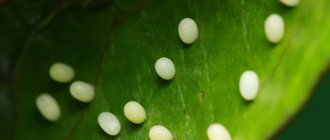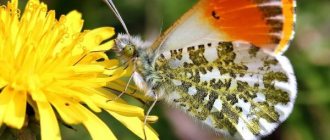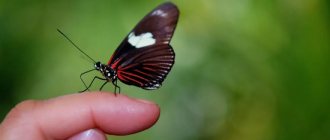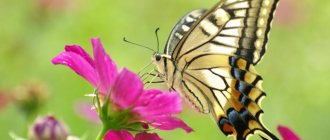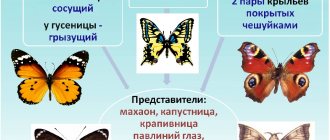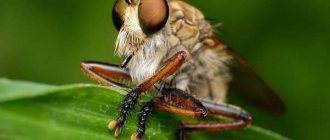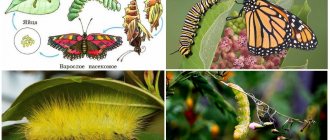Butterfly species
| Queen Alexandra's Birdwing | |
| Female (top) and male (bottom), not to scale | |
| Save Status | |
| Endangered (IUCN 3.1) [1] | |
| Scientific classification | |
| Kingdom: | Animalia |
| Type: | Arthropods |
| Class: | Insect |
| Order: | Lepidoptera |
| Family: | Papilionidae |
| Genus: | Ornithoptera |
| Subgenus: | Straatmana Deslile, 2007 |
| Variety: | O. alexandrae |
| Binomial name | |
| Ornithoptera alexandrae Rothschild, 1907 | |
Ornithoptera alexandrae
,
Queen Alexandra's birdwing
, is the largest butterfly species in the world, with females achieving a wingspan of 25 to 28 cm (9.8 to 11 in). [2] [3] This birdwing is native to the forests of Oro Province in eastern Papua New Guinea.
The species is critically endangered and one of only three insects (the other two are butterflies) to be listed on Appendix I of CITES, making commercial international trade illegal. [4]
History[edit]
The species was discovered in 1906 by Albert Stewart Meek, a collector hired by Walter Rothschild to collect natural history specimens from New Guinea. The following year, Rothschild named the species after Alexandra of Denmark. Although the first sample was taken with a small shotgun, Mick soon discovered the early stages and bred most of the early specimens. [5]
Although most authorities now place this species in the genus Ornithoptera
, it was previously
classified
in the genus
Troides
or the now defunct genus
Aethoptera
.
In 2001, lepidopterologist Gilles Deslyle proposed placing it in its own subgenus (which some authors have treated as a genus); he originally proposed the name Zeuner
, but this is a junior homonym (with
Zeuner's
Python 1936 [Orthoptera]), and its replacement is
Straatmann
. [6]
Urania Madagascar (Chrysiridia)
This flying insect has a unique rainbow color that attracts curious glances. Many connoisseurs of wildlife dream of examining Urania in detail in order to understand where exactly its attractiveness lies.
The scales of this insect shimmer in daylight, creating a rainbow effect. The surface sparkles with green, blue, red and yellow.
The unusual color of Urania has protective functions. He warns insect eaters that this butterfly is poisonous.
Nature outlined the edges of the wings of these creatures with snow-white lines, which give the appearance of the butterfly a finished look. Thanks to the white edges, the iridescent shimmer does not look too bright. Scientists note that the color of Uranium is not always symmetrical.
The span of Urania's magical wings is 9 cm. At the ends there are long processes that give the butterflies a unique appearance.
This species was discovered in the late 18th century by an English scientist named Drew Drury.
Urania Madagascar is a diurnal butterfly that likes to move long distances during daylight hours along with a flock of its relatives. When darkness falls, rainbow butterflies retreat together to a quiet and safe place to rest.
Description[edit]
For terms, see External morphology of Lepidoptera.
Female:
The female Queen Alexandra's bird wings are larger than the males, with noticeably more rounded and wider wings. The female can reach and slightly exceed a wingspan of 25 cm to 28 cm (9.8 in to 11 in), a body length of 8 cm (3.1 in) and a mass of up to 12 g (0.42 oz). Huge size for a butterfly. The female has brown wings with white markings arranged in two rows of chevrons. The hind wings are brown with an underwater line of yellow triangles in the center. The body is cream colored and there is a small patch of red fur on the brown chest.
Male:
This species is sexually dimorphic.
The wings are long, with an angular apex. They are iridescent, bluish-green, with a black stripe in the center. There is a distinct sex brand. The underside is green or blue-green with black streaks. Males are smaller than females. The abdomen is bright yellow. The wingspan of males can be approximately 20 cm (8 in), but is more commonly around 16 cm (6.3 in). The showy form of the male is the atavus
, which has golden spots on the hind wings. [7]
Giant water bug
The largest freshwater insects are considered to be giant water bugs, which are classified as Hemipterans. This family is divided into two main types: carnivores and herbivores. Their body length is 10 cm. They feed by introducing special, irritating substances into the bodies of victims. The victims of these insects are mainly small snakes and turtles. However, giant water bugs also often bite people. The sensation from the bite of this giant insect on the Schmidt scale, according to which pain and strength are measured, reaches 4 points - the highest point on the scale. For comparison: a wasp sting does not exceed 2 points. In addition, the bite can cause permanent damage to the muscles.
Biology [edit]
Eggs[edit]
The eggs are large, light yellow, flattened at the base, attached to the surface on which they are laid by a bright orange substance. Under ideal conditions, the Queen Alexandra Birdbird is capable of laying over 240 eggs in its lifetime.
Larva [edit]
Pararistolochia
(some species were formerly
Aristolochia
)
Newly emerged larvae eat their own eggshells before feeding on fresh foliage. The larva is black with red tubercles and has a cream-colored stripe or saddle in the middle of the body.
Side view of a Queen Alexandra Birdwing butterfly caterpillar.
The larvae of this species feed on the shell from which they hatched and then begin to extract nutrients from the pipe vines of the genus Pararistolochia
(family Aristolochiaceae), including
P. dielsiana
and
P. schlecteri
. They first feed on the fresh foliage of host plants and their own eggs, eventually causing a ringbark to the vine before pupating. Plants in the family Aristolochiaceae contain aristolochic acid in their leaves and stems. It is believed to be a strong vertebrate poison that is accumulated by the larvae during their development.
Pupa [edit]
The pupa is golden yellow or brown with black markings. Male dolls can be identified by a faint charcoal marking on the wings; this becomes a band of special scales in the adult butterfly, called a sexbrand. The time required for this species to develop from egg to pupa is approximately six weeks, with the pupal stage taking a month or more. Adults emerge from their pupae early in the morning when humidity is still high, as the huge wings can dry out before fully expanding if humidity drops.
Imago [edit]
Dorsal photograph of the holotype of the female Queen Alexandra Birdwing Butterfly.
Adults can live three months or more and have few predators except large orb-weaving
(
Nephila
.) and some small birds.
Adults feed on flowers, providing adults with a wide landing platform, including hibiscus
. Adults are powerful fliers and are most active early in the morning and again at dusk when they actively feed on flowers.
Males also patrol host plant sites in the early morning for newly emerged females. Females can be seen searching for host plants most of the day. The courtship is short but impressive; males hover over a potential mate, showering her with pheromone to induce mating. Receptive females will allow the male to land and mate, while non-receptive females will fly away or otherwise prevent mating. Males are very territorial and will see off potential rivals, sometimes chasing small birds as well as other poultry species. The flight is usually high in the rainforest canopy, but both sexes descend to within a few meters of the ground when feeding or laying eggs.
Tree lobster
The tree lobster is also called the giant stick insect. This is one of the largest insects on our planet. Today there are very few of them left in the world. For a long time, the giant stick insect was considered a completely extinct species, until several of these insects were found on one small Australian island. Scientists managed to increase their population. Despite the lack of wings, the tree lobster is able to move quickly. The reproduction process of this species has its own unique characteristics. The giant stick insect does not need a male to reproduce. When laying eggs, the female creates her own clone.
Threats and conservation[edit]
Raise a flagship profile with established specimens collected or bred when the insect is not endangered.
The Queen Alexandra Birdwing is considered endangered by the IUCN, [1] limited to approximately 100 km 2 (40 sq mi) of coastal rainforest near Popondetta, Oro Province, Papua New Guinea. However, it is locally abundant and requires old-growth rainforest for its long-term survival. The main threat to this species is the destruction of oil palm plantation habitats. However, the eruption of nearby Mount Lamington in the 1950s destroyed a very large area of the species' former habitat and is the main reason for its current rarity.
The species is also highly sought after by collectors, and due to its rarity, this butterfly sells for a very high price on the black market, reportedly ranging from US$8,500 to US$10,000 in the US in 2007. [8] In 2001, the famous Canadian researcher Gilles Desliles. was fined C$50,000 for illegally importing six specimens of Queen Alexandra's bird wings. [9] In 2007, "global butterfly smuggler" Hisayoshi Kojima pleaded guilty to 17 counts after selling a number of endangered butterflies, including a pair of Queen Alexandra bird's wings for US$8,500, to a special agent of the Fisheries Conservation Service and US Wildlife. [8]
Early collectors, frustrated by the altitude of the adults during the day, often used small shotguns to bring down specimens, but since collectors demand high quality specimens for their collections, most specimens are reared from larvae or pupae.
Although foragers are often implicated in the extinction of this species, habitat destruction is the main threat.
The species is listed on CITES Appendix I, meaning international commercial trade is illegal. At a meeting of the CITES Animal Committee in 2006, some suggested moving it to Appendix II (which would limit trade in the species) because the conservation benefits of sustainable management were arguably greater than those of a trade ban. [10]
Peacock's eye (Agalisio)
This is the most famous butterfly that fascinates people with its bright colors. On her wings nature painted four blue-black eyes with blue dots. With their color scheme they resemble the color of a peacock. The main color of the scales is bright red.
The wingspan of this beauty is small, only 5.5 cm. The life expectancy of an individual is nine months.
In winter, the butterfly hides from the cold in tree hollows and cracks in the bark. With the arrival of spring, the Peacock's eye leaves its cozy shelter.
This species can be found in Eurasia and Japan. These butterflies are permanent residents of forest and park areas. They also live in the mountains, boldly rising to a height of 2.5 km above sea level.
Gallery[edit]
A selection of museum exhibits from Queen Alexandra's bird wing
- Top/top view of the bird wing of an adult male Queen Alexandra.
- Ventral/ventral view of an adult male Queen Alexandra's birdwing.
- Top/top view of the bird wing of an adult female Queen Alexandra.
- Ventral/ventral view of an adult female Queen Alexandra's birdwing.
- Pupa, side view
Atlas
The second name of this butterfly is Prince of Darkness. She loves the dark. The butterfly is large. The wingspan of Atlas is 30 cm.
While the Prince of Darkness is in a caterpillar state, he gains strength. The caterpillar actively stores nutrients to feed itself when it transforms into a butterfly.
Many animals love to eat butterflies. Therefore, nature has come up with its own means of protection for these harmless flying creatures. If you look closely at the coloring of the Prince of Darkness, you will notice that the pattern on his wings resembles the head of a snake. Seeing a dangerous rival, the animals try to hide, mistaking the pattern on the insect's scales for a poisonous enemy.
Atlas cannot boast of a long life span. After birth, he enjoys this world for only ten days, and then dies.
Links[edit]
- ^ a b Jimenez Dixon, M. (1996). » Ornithoptera alexandrae » . IUCN Red List of Threatened Species
.
1996
: e.T15513A4722611. DOI: 10.2305/IUCN.UK.1996.RLTS.T15513A4722611.en.CS1 maint: uses the authors parameter (link) - ↑
November 2010, Remy Melina 04. “What is the biggest butterfly?”
. livescience.com
. Retrieved July 13, 2022. - "Queen Alexandra Birdwing Butterfly Facts for Kids and Adults: Images, Information and Video". Active wild
. 2017-01-24. Retrieved July 13, 2022. - CITES Appendices I, II and III, official website
- https://www.nhm.ac.uk/discover/butterflies-with-bullet-holes.html
- Deslisle, G. (2007) "Straatmana: a remplacement name for the subgenus Zeunera Deslisle 2001 (LEP Papilionidae.)" Lambillionea
(Brussels) N ° 2 v 1 & 2, June 2007, p. 238 - "Endangered Species - Facts about Queen Alexandra's Poultry Farm". Retrieved February 17, 2009.
- ^ ab O'Neill, Helen (20 August 2007). "The US will finally catch the global butterfly smuggler." NBCNews.com
. - "Seizures and Prosecutions" (PDF). MOVEMENT Bulletin
.
TRAFFIC International. 19
(2): 76–79. 2002 - CITES (2006). Earth Negotiations Bulletin. Results of the 22nd meeting of the CITES Animal Committee.
- Parsons, Michael J. 1984 Biology and Conservation of Ornithoptera alexandrae
.
In: Biology of Butterflies,
edited by Vane-Wright and Eckery. Symposia R. ent. Soc. London. 11, pp. [327-332] - Parsons, Michael J. 1987 Butterflies of Papua New Guinea
. - Parsons, M. J. 1992. Butterfly farming and trade in the Indo-Australian region and its role in tropical forest conservation. Tropical Lepidoptera
3(Suppl. 1): 1-31. pdf Full text - Parsons, M., 1999 Butterflies of Papua New Guinea - their taxonomy and biology
. Academic Press, London - Straatman, R. 1971 Life History of Ornithoptera alexandrae
Rothschild
Journal of the Society of Lepidopterists
1971 Vol 25: 58-64. pdf - D'Abrera, B. (1975) Winged Butterflies of the World
. Books about Country Life, London. - Collins, N. Mark; Morris, Michael G. (1985). Threatened swallowtail butterflies in the world: The IUCN Red List. Gland and Cambridge: IUCN. ISBN 978-2-88032-603-6 - via Biodiversity Heritage Library.
- Haugum, J. & Lowe, A. M. 1978–1985. Monograph of tarantula butterflies
. 2 volumes. Scandinavian Press, Klampenborg; 663 pp. - Deslisle, G. (2004) Taxonomic revision of the "paradise tarantula butterflies", genus Ornithoptera, based on adult morphology (Lepidoptera, Papilionidae). Lambillionea
, 104 (4): 1 – 151.
Reproduction
The butterfly development cycle lasts four months. The adult lives for three months. The caterpillars' food plants are Aristolochia dielsiana and Aristolochia schlechteri. The caterpillars grow up to 12 cm in length and 3 cm in thickness.
- 1 2 3 4 L. V. Kaabak, A. V. Sochivko Butterflies of the world / G. Wilchek. - Moscow: Avanta+, 2003. - P. 86. - 184 p. - (The most beautiful and famous). — 10,000 copies. — ISBN 5-94623-008-5, ISBN 5-98986-071-4
- 1 2 3 V. Landman Butterflies. Illustrated encyclopedia / scientific. reviewer Divakova S.V. - Moscow: Labyrinth Press, 2002. - P. 71. - 272 p. — (Illustrated Encyclopedia). — ISBN 5-9287-0274-4
- Kravchuk P. A. Records of nature. - L.: Erudite, 1993. - 216 p. — 60,000 copies. — ISBN 5-7707-2044-1
- Ornithoptera alexandrae - www.iucnredlist.org/apps/redlist/details/15513/: information on the IUCN Red List website (English)
- N. Mark Collins, Michael G. Morris Threatened Swallowtail Butterflies of the World: The IUCN Red Data Book - books.google.co.uk/books?id=RomV7uO_t9YC&pg=PA288&vq=Ornithoptera alexandrae&dq=Ornithoptera alexandrae&lr=&as_brr=3&hl=ru&source= gbs_search_s&sig=R14iNU6hDDUnvQgDq5BWClhgZgU. - IUCN, 1985. - P. 288. - 401 p. — ISBN 2880326036
This abstract is based on an article from Russian Wikipedia. Synchronization completed 07/11/11 13:36:58 Similar abstracts: Ornithoptera Queen Victoria, Ornithoptera Rothschild, Ornithoptera paradise, Ornithoptera goliath, Ornithoptera priamus, Ornithoptera typhon, Ornithoptera cresus, Ornithoptera chimera. Categories: Animals in alphabetical order, Swallowtails, CITES Applications, Animals described in 1907, Insects of Oceania, Ornithoptera.
Madagascar comet (Argema mittrei)
This bright beauty received the status of the longest butterfly in the world. Its wings have a yellow-orange tint. Their peculiarity is that at the ends there are processes 20 cm long. That is why it was nicknamed “comet”. The butterfly loses these “tails” after the first 2-3 flights.
The life of the Madagascar comet is very short - only a few days. The butterfly does not have a digestive tract because it does not need food. The mouth is also missing. During the time that the Comet is in the caterpillar state, it accumulates a lot of nutrients for future use. Moreover, her life is so short that it would be inappropriate to waste precious hours and days on meals.
Coscinocera Hercules
Peacock-eye Hercules, this is the name of the next large butterfly, which will be discussed below. This amazing creature of nature lives in distant Australia, as well as on islands nearby, such as New Guinea. The wingspan of this insect sometimes exceeds 280 mm. Moreover, females have the largest area (this parameter is also used in science) of wings, which can reach 263 cm2. Because of this, in fact, it got its name in honor of the mythical ancient hero.
As a rule, in its natural habitat, the Coscinocera hercules butterfly feeds on such plants (at the caterpillar development stage) as brook tree and late bird cherry. But, it should be noted that in captivity, the caterpillars of this insect can perfectly adapt to other “ingredients” of their diet. So in our area you can grow Peacock-Eyes Hercules on walnuts, privets, even the well-known lilac or even willow.
In conclusion, it must be said that it is quite difficult to see such an unusual and quite rare butterfly for many reasons, among which, perhaps, it is worth highlighting one. This insect is exclusively nocturnal. As a result, it is almost impossible to see it (given its protective coloring) in the tropical forest where it lives.

